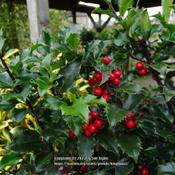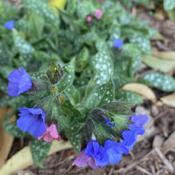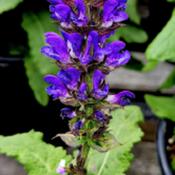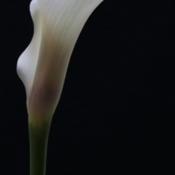| Image | Plant | Status | Notes | Events |
|---|---|---|---|---|
 |
Meserve Hybrid Holly (Ilex Blue Princess) |
Have |
Purchased Sept 23 2022 from Inline Propagator Plant Sale $5 Blue-green foliage, white spring flowers, and bright red berries in fall that persist through the winter are all reasons to add a few 'Blue Princess' holly shrubs to your yard. Ilex x meserveae 'Blue Princess' is a female hybrid developed to be more cold-hardy than other hollies. Holly 'Blue Princess' make excellent privacy screens and hedges. When kept trimmed, their size and dense nature make a beautiful but effective live fence. Holding on to its classic dark green and glossy leaves all year round, 'Blue Princess' hollies makes a property-enhancing border or a classic backdrop to perennial beds and gardens. Evergreen shrubs are an easy and natural way to gain a visual screen in places where you don't want a human-made fence. Ilex holly 'Blue Princess' fills that need and also makes an effective windbreak. Holly 'Blue Princess' shrub is an excellent choice to bring wildlife to your yard. Small white flowers in the spring become the classic red holly berries in the fall. Birds love these shrubs for their berries and for shelter and perching. Tip: Plant one male hybrid holly for every 4-5 female hybrid hollies to ensure the best berry crop. Plant a few 'Blue Princess' hollies and dress up your property. Your songbirds will love them. 'Blue Princess' Holly Care Information 'Blue Princess' hollies can be grown in USDA zones 5-8. They are moderately cold-hardy but need protection from cold, drying winter winds at the northern edge of their range. 'Blue Princess' is happy with full to partial sun. It will benefit from a bit of afternoon shade if you are at the southern end of its range. 'Blue Princess' holly is tolerant of most soils but will do best on moist, fertile, well-drained sites. No pH adjustments should be needed unless your soils are highly acidic or alkaline. Mulch under your new 'Blue Princess' holly to control weeds, grasses, and even-out soil moisture levels. Reapply mulch yearly or as necessary. Blue Princess Holly Height And Width This hybrid holly can reach an impressive 10' tall and 8' wide at maturity. 'Blue Princess' holly can be planted closer together for a quick, dense privacy screen or windbreak. Regular pruning will make a shorter, more uniform hedge. If left unpruned and wild, the 'Blue Princess' holly can sometimes reach heights of 15 feet. It is also common to see this planted as a Blue Princess Holly Tree. Blue Princess Holly Growth Rate A moderately fast grower, 'Blue Princess' hollies can add 1-2 feet per year. Plant them in a line spaced closely together if you want a thick, shearable hedge or holly fence. We recommend spacing the Ilex Blue Princess 4-6 feet apart to create a holly hedge look. Blue Princess Holly Pruning Needs Princess Blue Holly only needs pruning for shaping and removing injured or dead stems. Of course, you may want to trim off a few branches to use as winter decorations. Remember that this holly blooms on 'old wood,' meaning that if you trim off too many branches in the fall, you will get fewer berries the following year. 'Blue Princess' can be sheared to make a formal hedge and will fill in nicely. If left wild, it will become pyramidal and have a somewhat more open form |
September 24, 2022: Obtained plant ($5) |
 |
Variegated Purple Moor Grass (Molinia caerulea 'Variegata') |
Have |
Purchased from Inline Propagator $7 Sept 24 2022. Purple moor grass (Molinia caerulea) is a perennial grass native to Eurasia and North Africa. It is a highly variable species and two subspecies are often recognized – subsp. caerulea and subsp. arundinacea – but many intermediates occur. The cultivar 'Variegata' is a superior ornamental selection from the caerulea group with lovely variegated foliage. This cool-season, clump-forming bunchgrass is found in moist heathland, bogs and moorland in its native habitats, and is hardy in zones 4-9. This is a short and delicate grass compared with many commonly used ornamental grasses. Dense clumps grow 12-18″ tall, gradually getting wider over the years – but often forming a hollow center as many grasses do when mature. The coarse leaves are long, flat and taper to a point at the end. Variegata forms dense clumps with variably striped foliage. 'Variegata' forms dense clumps with variably striped foliage. The foliage is striped lengthwise in green and creamy white, with considerable variation in the number and width of the stripes. In autumn, the foliage turns to a burnished gold and dies back completely over the winter. The foliage and flower stalks do not hold up well, typically falling over in late fall, so it is not useful for providing winter interest like many other ornamental grasses and can be cut to the ground once it yellows. This cultivar is often slow to emerge again in spring, so it may be helpful to mark the position of clumps so they won't be accidentally disturbed or damaged before they come up. Any remaining foliage should be removed in spring before new leaves appear. Airy flower spikes are produced in summer. Airy flower spikes are produced in summer. This is one of the latest-blooming Molinias, with airy flower spikes rising well above the foliage in mid- to late summer. The panicles have several long narrow spikelets with a slight purple tinge (often overlooked) that fade to a rich golden yellow to brown color. They are especially nice when positioned so the bronze inflorescences are backlit by the late afternoon sun. They can be used in dried arrangements but do not hold up well over the winter as many other ornamental grasses. This cultivar does not produce seed readily, so volunteers are not a problem. Variegated purple moor grass is great as a small specimen, in perennial or mixed beds, or even in containers. It is quite showy when planted in groups, as an accent at the front of the border, amid dwarf conifers, or along paths. With its fine texture and bright color, it looks especially nice when planted near dark-foliaged plants of medium or coarse texture, such as purple-leaved Sedum 'Bertram Anderson' or Sambucus Black Lace™ (or other cultivars) or blue-leaved Hostas. It combines nicely with ferns and pulmonaria in lightly shaded spots, and with autumn-flowering plants, such as asters, goldenrods or helenium, that will draw attention away from the withering foliage. Since it does well in moist soil, other good companions include cardinal flower (Lobelia cardinalis), monkshood (Aconitum sp.), and eupatoriums. M. caerulea can be slow to establish. It does best in full sun in cool climates, but needs some shade in hotter locations. It likes ample water and fertile soils. It has few pests, is not preferred by deer, and is not affected by juglone, so can be grown near black walnut trees. This slow-growing cultivar rarely needs to be divided and resents being disturbed, but it can be propagated by division in the spring just as the foliage is emerging. |
|
 |
Bee Balm (Monarda 'Bee-Free') |
Have |
April 24, 2021: Obtained plant ($5 Cedar Rim) | |
 |
Garden Phlox (Phlox paniculata Ka-Pow® White Bicolor) |
Have |
Purchased from Devon Nursery 2022 July Mature Size 16-18" tall by 14-16" wide. Prune to ground in late winter before new growth begins. |
July 1, 2022: Obtained plant |
 |
Lungwort (Pulmonaria 'Twinkle Toes') |
Have |
Purchased from Inline Propagators Plant Sale Sept 23 2022. $5 Among the first spring bloomers, Pulmonaria 'Twinkle Toes' is an extremely vigorous Lungwort with mildew resistance that bursts into blossom in mid-April in our area and then continues the performance for 3 weeks with periwinkle blue blossoms topping deep green leaves spotted with silver. PP 30,258 These shade-loving natives of Europe and Asia are among the easiest and most desirable perennials for low light. Pulmonarias spread slowly from the initial clump to form an attractive ground cover. Choose a spot for them that stays moist (not wet) and has soil rich in organic matter. Cutting off old leaves right after bloom will stimulate a fresh crop that will look good for the rest of the season. They make an exquisite underplanting for Ferns, Hostas, and spring-flowering bulbs such as Daffodils. They're also useful as a soft but bright edging for a shady border. |
September 24, 2022: Obtained plant ($5) |
 |
Rose (Rosa 'Topaz Jewel') |
Have |
Planted around new Fig and blooms are pink! | |
 |
Perennial Woodland Sage (Salvia nemorosa) |
Have |
Purchased from Inline Propagators Garden Sale $5 Sept. 23 2022. One of the most commonly used salvias in the northeastern US, it is covered in striking dark violet-blue flower spikes in May and June and remains upright and tidy throughout the season. Attracts birds, butterflies and bees. Makes an excellent cut flower, fresh or dried, and its leaves are freshly aromatic. An overall low maintenance selection. Combine with brilliant yellows and whites for a bold display in the garden. |
September 24, 2022: Obtained plant |
 |
Meadow Sage (Salvia nemorosa 'Caramia') |
Have |
Purchased Sept 23 2022 from Inline Propagator's Plant Sale $7 Salvia nemorosa 'Caramia' Perennial Sage USDA Zone: 3-9 Plant number: 1.468.740 The Perennial Sages are invaluable perennials for their rich display in the border. Plants form a bushy clump of grey-green leaves, with upright spikes appearing in early summer, attractive to both butterflies and hummingbirds. This selection features dark purple flower spikes on dark stems and is compact. Remove faded flowers to encourage repeat blooming, or simply cut back hard after flowering is finished. Plants are reasonably drought tolerant, once established. Excellent for cutting. Clumps may be easily divided in early spring, every 3 to 4 years. Further details for Salvia nemorosa 'Caramia' Optimal Growing Conditions Sun Exposure Full Sun Soil Type Normal or Sandy or Clay Soil pH Neutral or Alkaline or Acid Soil Moisture Average or Dry or Moist Care Level Easy Appearance and Characteristics Flower Colour Purple Blooming Time Early Summer Mid Summer Foliage Color Grey Green Plant Uses & Characteristics Accent: Good Texture/Form Attracts Butterflies Attracts Hummingbirds Border Containers Cut Flower Deer Resistant Drought Tolerant Edging Rabbit Resistant Fragrant Massed Flower Head Size Large Height 35-40 cm 14-16 inches Spread 35-40 cm 14-16 inches Foot Traffic None Growth Rate Medium |
September 24, 2022: Obtained plant ($7) |
 |
Calico Aster (Symphyotrichum lateriflorum) |
Have |
April 19, 2021: Obtained plant (Country Garden) | |
| Half-High Blueberry (Vaccinium corymbosum 'Polaris') |
Have |
Purchased two from Inline Nursery Sept 23 2022 $7 each. A very hardy hybrid blueberry of upright spreading habit, produces flavourful light blue fruit in early summer; requires highly acidic soil, excellent drainage and a good mulch, plant with plenty of peat moss. Cross pollinate for increased production. Edible Qualities Polaris Blueberry is a small shrub that is typically grown for its edible qualities, although it does have ornamental merits as well. It produces clusters of blue round berries with purple overtones which are usually ready for picking in mid summer. The berries have a sweet taste and a juicy texture. The berries are most often used in the following ways: Fresh Eating Cooking Baking Preserves Features & Attributes Polaris Blueberry features dainty clusters of white bell-shaped flowers with shell pink overtones hanging below the branches in mid spring. It has green deciduous foliage. The glossy oval leaves turn an outstanding orange in the fall. It features an abundance of magnificent blue berries with purple overtones in mid summer. This is a multi-stemmed deciduous shrub with an upright spreading habit of growth. Its relatively fine texture sets it apart from other landscape plants with less refined foliage. This is a relatively low maintenance plant, and usually looks its best without pruning, although it will tolerate pruning. It is a good choice for attracting birds to your yard. It has no significant negative characteristics. Aside from its primary use as an edible, Polaris Blueberry is sutiable for the following landscape applications; Orchard/Edible Landscaping Planting & Growing Polaris Blueberry will grow to be about 3 feet tall at maturity, with a spread of 3 feet. It tends to be a little leggy, with a typical clearance of 1 foot from the ground. It grows at a fast rate, and under ideal conditions can be expected to live for approximately 20 years. This variety requires a different selection of the same species growing nearby in order to set fruit. This shrub is quite ornamental as well as edible, and is as much at home in a landscape or flower garden as it is in a designated edibles garden. It does best in full sun to partial shade. It does best in average to evenly moist conditions, but will not tolerate standing water. It is very fussy about its soil conditions and must have sandy, acidic soils to ensure success, and is subject to chlorosis (yellowing) of the foliage in alkaline soils. It is quite intolerant of urban pollution, therefore inner city or urban streetside plantings are best avoided, and will benefit from being planted in a relatively sheltered location. Consider applying a thick mulch around the root zone in winter to protect it in exposed locations or colder microclimates. This particular variety is an interspecific hybrid. |
September 24, 2022: Obtained plant | |
 |
Calla Lily (Zantedeschia aethiopica) |
Have |
November 15, 2022: Winterized ( the best time when to dig Calla Lilies is right after the frost has killed the foliage. This is going to ensure that your Calla Lilies have stored all the nutrients they are able to survive over winter. The next step to care Calla Lilies over winter is after you dig them up, you have to brush off any remaining dirt gently. Please do not wash the Calla Lilies rhizomes off because this will be able to cause the rhizomes to rot later on. After that, you have to cut off the foliage from the top of the rhizomes, leaving approximately 2 to 3 inches or 5-7.5 cm of the dead leaves. After this, you have to leave the rhizomes to dry in a warm and dry place to dry for 4 to 7 days. This is very crucial for Calla Lilies care in winter as it allows the outer skin of the rhizome to toughen up, and will assist it survive the winter. This is known as curing. After the Calla Lilies rhizomes have already dried, you are able to place them in a paper bag. Or you are also able to wrap them in newspaper. Please store them in a cool and dry place, somewhere that stays around 10 C (50 F). Of course, proper Calla Lilies winter care is very crucial to having those lovely flowers in your garden year after year. Great Way to Store Calla Lilies Over Winter Firstly, you have to cut back your Calla Lilies' inflorescences to 3 inches above the soil line by using garden shears after the first light frost yellows or damages the foliage. Loosen the soil 3 to 6 inches from the base of the callas by using a garden trowel. Please work the trowel around 6 inches under the Calla Lilies. Loosen the soil ball containing the rhizome and its roots by rocking it up and down. Then, lift the soil ball and the lilies from the ground. You need to pick away the big clumps of soil from the rhizomes and roots with a wood skewer or pencil. Please place the rhizomes under cool-running water to rinse away the soil. Now, you are able to space the Calla Lilies around 2-inches apart in a single layer on a table placed out of direct sunlight and shielded from the rain and wind. Let the Calla Lilies cure outside for 3 days to a week if the temperature remains between 60 and 70 degrees F. The next step is to scrape away any remaining soil from the rhizomes and roots by using a wood skewer or pencil. Please tag the inflorescences with a garden tag with the cultivar name written on it. Also, you are able to write the cultivar name on the rhizome with a permanent marker. You need to line the bottom of a vented plastic container with 1 to 2 inches of substrate like peat moss or vermiculite. Just space the Callas Lilies approximately 1-inch apart on the substrate. If you do not have a vented plastic container, you are able to use a cardboard box with some holes punched in the sides. Now, you have to cover the Calla Lilies with 1 or 2 inches of substrate. Ensure that you fill the spaces between them. Please place the container in a frost-free room with low humidity and a temperature between 40 and 50 degrees F until the danger of frost ends in spring. Look at the Calla Lilies every week or two over winter and check for drying and wrinkling. You need to spray the substrate several times with water from a spray bottle if your rhizomes look a bit dry. If needed, you are able to soak a utility knife in a solution of 9 parts water and 1 part all-purpose bleach for 15 minutes to sterilize it and then cut away any rotted or moldy portions of the rhizomes. Please replace any substrate which appears or smells rotten or moldy. ) |